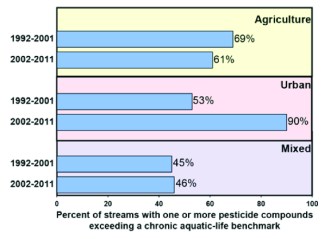I count this this brand new study as good news. Between 1992 and 2001, the U.S. Geological Survey found that 17 percent of streams it was monitoring contained enough pesticide that you’d start to worry about human health. Between 2002 and 2011, that dropped to just one — not 1 percent, but one stream out of 125 monitoring sites on streams, rivers, and irrigation ditches nationwide. The difference seems to stem from regulatory changes. Hey, sometimes government works!
This data comes from a 20-year study to monitor pesticides in streams draining agricultural, urban, and mixed-land use watersheds. It provides a representative snapshot of stream health across the U.S.
 There was less progress when it comes to bug health — there are still worrying levels of pesticides for the aquatic ecosystem in the majority of rivers monitored. There was a big increase in a couple pesticides in urban streams — fipronil and dichlorvos, which are used by city dwellers trying to kill ants, or cockroaches, or fleas on their pets. But that was largely because the USGS just started monitoring for them in this last decade.
There was less progress when it comes to bug health — there are still worrying levels of pesticides for the aquatic ecosystem in the majority of rivers monitored. There was a big increase in a couple pesticides in urban streams — fipronil and dichlorvos, which are used by city dwellers trying to kill ants, or cockroaches, or fleas on their pets. But that was largely because the USGS just started monitoring for them in this last decade.
Pesticides are a tricky thing to measure — you have to take into account their varying levels of toxicity, and the different ways they affect different species. You have to consider how quickly they break down, and what they break down into. This assessment does a good job of doing all that. By looking at the pesticides that make their way into streams, we capture a big-picture sense of of the issue.
That big picture: We’ve cleaned up the rivers for humans, but we still have a ways to go for our non-human friends.



